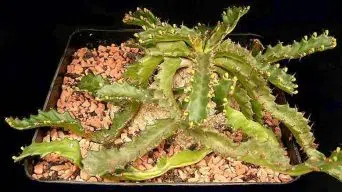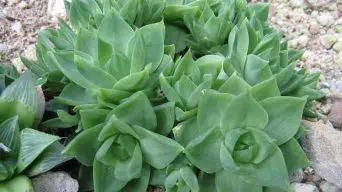Euphorbia milii is a succulent plant that has been popular for quite some time now.
It’s also known as the Crown of Thorns plant, and it originates in Madagascar.
This Euphorbia species is one of the easiest to propagate, which makes them perfect for beginners!
In this article, we will cover how to take care of Euphorbia milii to grow into healthy plants and propagate them too!
Overview
The Euphorbia milii succulent plant is often called the Crown of Thorns or Christ plant. The spiny, sharp thorns resemble the thorns that adorn a crown.
The Euphorbia species is native to Madagascar but can be found throughout Africa and parts of Asia.
The Crown of Thorns plant is a popular houseplant because it can be grown in less-than-ideal conditions and thrives well indoors.
There are many different varieties of Euphorbias available. Still, some common ones include Euphorbia tirucalli ‘Sticks On Fire’, Euphorbia milli ‘Poinsettia’ and Euphorbia Milii ‘Crown Of Thorns’.
These euphorbias are all cactus-like plants that range in size from small to large. The Euphorbia milii succulent plant is grown for its distinctive spikes, which can grow up to 16 inches tall and have a thorny exterior.
This Euphorbia is a flowering plant that has a unique and beautiful appearance best characterized by tiny flowers that grow in clusters and are subtended by spectacular red or yellow bracts.
The Crown Of Thorns succulent is a popular houseplant because it can be grown in less-than-ideal conditions and thrives well indoors.
How To Care for Euphorbia milii (Crown of Thorns)
Getting Euphorbia milii care right will help your plant thrive and grow to maturity with little effort.
Here are some things you need to know about taking care of the Crown of Thorns succulent plant.
Sun Exposure & Light Requirements
The Euphorbia milii succulent needs light from sun exposure throughout the day! It does not do well with too much direct sunlight and prefers indirect or filtered light.
You can grow them indoors with artificial light, but they require at least four hours of direct sunlight every day.
They can also grow and thrive outdoors with enough sun exposure.
The Euphorbia milii plant does best when it has plenty of light. The lights help the plant produce sugar for energy. It can use this energy during dry periods to survive.
Without this process happening, the Euphorbia will turn brownish-grey in color. It needs at least four hours per day outside under direct sunshine on clear days and less than four hours inside if there is not enough natural light.
Watering Requirements
The Euphorbia milii succulent plant is a very drought tolerant plant, so you only need to water it once every one or two weeks.
The Crown of Thorns needs to be watered only when the soil is dry.
When watering the Euphorbia milii succulent plant for the first time in an area that has experienced dry, hot weather, then make sure and give it plenty of water to soak up.
A good indicator if your Crown of Thorns plant needs more water would be its leaves curling inward. If this happens, please increase your watering schedule to provide enough moisture until signs of new growth appear again.
The Euphorbia milii can suffer from overwatering, which will cause their roots to rot and brown spots on the leaf where they touch the ground.
If you are in a climate with wet, cool weather, it is best to water the Crown of Thorns every two weeks. It needs less water than succulents from dry climates and will have brown or yellow leaves if overwatered.
Soil Requirements
The Euphorbia milii does well in well-drained, loose soil. It does not do well in clay soil. You can amend the soil with sand or perlite to make it more loose and well-drained.
The Crown of Thorns succulent plant does well in soil that has the following properties:
- The Euphorbia milii needs a pH range of around neutral or slightly acidic. The succulent will grow faster and produce more flowers if the soil is close to neutral.
- There is a lot of humus in the soil. It will come from worm castings, compost, and some types of manure. But you can also use peat moss or leaf mold as an alternative if you do not have any of these products to provide the humus for your soil.
- Is well-drained with adequate drainage systems in place, so water doesn’t pool around the Crown of Thorns (unless it often rains where you live)
- Has plenty of space for root growth between each Euphorbia milii plant
With these specific needs, the best choice of soil type is a succulent and cactus mix.
Temperature and Humidity
Ensuring that the conditions for your Crown of Thorns succulent are right is essential.
The perfect temperature range is between 65 and 85 degrees Fahrenheit (18-29 C).
Temperatures below 50 degrees at night will cause Euphorbias to go into a deep dormancy. In contrast, temperatures above 95 F can kill them outright.
Homes with central heating systems should be kept on a thermostat set no higher than 70 F during the day or 80 F in winter months.
At nighttime, it’s best if you turn off the heat altogether, as this plant cannot survive outside its specified temperature ranges.
If a furnace doesn’t heat your home, consider using floor or space heaters instead – keep them away from plants so they don’t get too hot.
Concerning humidity, Euphorbias should be kept in dry, arid climates where the humidity level is below 50%.
If your home has high levels of moisture, then consider using a dehumidifier.
Keep plants away from air conditioners and refrigerators. These can cause low temperatures, which Euphorbia milii succulent cannot survive.
Fertilizing
The best time for fertilizing Euphorbia milii is early spring. This will give them plenty of nutrients as their roots grow into new leaves.
You can also use diluted fertilizer on your plants. It is especially good for plants in pots since they have less soil than plants in the ground.
You only need to fertilize Euphorbia milii approximately once per month during their dormant period, which is from November through February.
Use a quarter dosage of what you used for other months. Do not use a fertilizer with nitrogen during this time of year because it will stimulate growth.
Growing Crown of Thorns plants indoors requires more frequent fertilization than outdoor plants.
The best way to tell when your Euphorbia needs water or nutrients is that its leaves start turning brown at the edges.
Once you notice these signs, give them water right away and supplementary feeding if desired until new green leaves appear.
Grass clippings or rotten fruit will make for a good Euphorbia milii fertilizer. They need to be mixed with compost and potting soil in equal proportions before being applied to the Euphorbia plants.
Potting and Repotting
When Euphorbia milii are getting root bound, they can be repotted into a new pot with fresh soil.
The best time to do this is in the spring or early summer when most plants grow and bloom better because of more sunlight hours.
Use the same type of potting mix as you have been using for your Euphorbia milii. If it has not had any amendments made, then just use the regular cactus mix.
When planting outdoors: make sure that there will be enough space in the area where you want to plant them for the Crown of Thorns to grow.
If planting indoors, make sure you have enough space in your home for these plants to get plenty of sunlight with a window or lamp.
When potting Euphorbia milii, water them thoroughly before and after transplanting so they don’t dry out entirely while adjusting to their new environment.
You may need more frequent watering depending on how much sun they are getting and if it is hot outside.
If using a cactus mix for repotting, add perlite as well because the earth tends not to provide good drainage due to its density when wet.
When planting Euphorbia milii outdoors, try to plant them in well-draining soil and keep them away from standing water.
If you have a Crown of Thorns that has gotten too tall for its pot, just cut the plant back to the desired height and put it in fresh soil.
Pruning
Since Euphorbias are succulents, they grow a lot during the spring and summer seasons.
Pruning is best done in late winter or early spring when new growth has slowed down.
This allows for healthy root systems to develop before next year’s active growing season begins.
To prune a Euphorbia milii, you can remove any parts of the plant that have grown too long (anything more than halfway up from where it meets the ground).
Additionally, cut off any rotted portions of the plant with sharp clippers or shears.
Be sure to remove any flowers and seed heads that have already died.
This will allow the plant to focus on its root system, which can be crucial for a healthy Euphorbia milii.
Do not prune your Crown of Thorns during late spring or summer when plants are at their most active growth period!
Pests and Diseases
Euphorbia plants have a few pests and diseases that can affect their growth.
Pests
A common pest is mealybugs, which feed on the Euphorbias sap and excrete an irritating substance called honeydew.
Aphids also tend to attack Euphorbia succulents, but they are more likely from nearby crops or garden areas than attacking the plant itself.
Scale insects may feed on the Euphorbia leaves in localized spots (also known as armored scale).
Other possible pests include caterpillars, beetles, weevils, and mites; all these will only cause damage if unattended for an extended period.
Diseases
Euphorbia succulents can affect symptoms of diseases by including leaf spot, stem rot, and powdery mildew.
These are typically caused by a lack of watering or exposure to colder temperatures than the Euphorbia is used to.
When these problems become chronic, they may lead to a stunted plant with reduced growth for years after they have been established in your garden.
A common disease found on Euphorbias plants called root rot will damage the roots so much that only small tufts remain as the rest has rotted away (this kind of damage occurs from overwatering).
Some other signs you might notice when dealing with this issue are wilting leaves even if there is water present—yellowing foliage where patches will turn a dark green or brown color.
The best way to avoid these diseases is by not overwatering your Euphorbia plants and maintaining their environment in the appropriate temperature range for them.
The other thing you should do is monitor any changes in growth patterns, such as wilting leaves even if there is water present.
If you see any of these symptoms, it’s probably time to check out what might be happening with that plant before the disease worsens.
How to Care for Euphorbia milii (Crown of Thorns) in Winter
It is important to note that Euphorbia milii plants are not cold-hardy.
They will begin to show signs of stress when the temperature dips below 70 degrees Fahrenheit and should be brought inside for winter care or moved into a warmer environment.
Euphorbias need a lot of light, so any place where there is high artificial lighting would be ideal (this includes offices).
Keep them away from drafts and cool air conditioning vents; they’re also sensitive to changes in humidity levels which can lead to leaf curl.
If you move your Euphorbia outdoors during the summer, ensure it’s protected from frost. Place it close enough to an outside wall that it won’t get cold overnight, or put something over it like a plastic sheet.
When the Euphorbia is outdoors, make sure to keep it in a sunny location and avoid windy areas that will dry out its leaves.
If you can’t bring your Crown of Thorns indoors or move it into a warmer environment for winter care, then you will need to prepare an area where cold temps won’t be too much of an issue.
Place potted Euphorbias close enough together so they’ll provide each other with some warmth. Also, consider getting one of those heated plant tents which are designed specifically for plants like these.
It’s important not to let them go completely dormant over winter – water sparingly every month during this time (you don’t want their roots going totally dry) and place them in a sunny window.
How To Propagate Euphorbia Milii (Crown of Thorns)
The Euphorbia milii (Crown of Thorns) can be propagated by cuttings.
- Take cuttings from the plant during the spring and summer months. Cut off a branch that is 12 to 15 inches in length.
- Place the cuttings in paper and let it callous over for a few days.
- Then, plant the cactus cuttings in well-drained soil.
- Keep dry during winter months and place an inch of sand on top to retain moisture.
- In the spring, water regularly and fertilize with a liquid fertilizer.
- The Euphorbia milii will thrive in well-drained soil, with plenty of light and warmth during the day.
It will take around four to six weeks for the Euphorbia milii cuttings to root and produce new growth.
Is the Euphorbia milii (Crown of Thorns) Toxic?
The Euphorbia milii succulent plant is mildly toxic for humans and causes irritation on contact with the skin or eyes.
Some people show signs of euphorbium poisoning in areas where the Euphorbia grows in large quantities. These include fevers, headaches, nausea, vomiting, and a rash.
The Crown of Thorns is very toxic for animals, and all Euphorbia plants should be kept out of reach.
Euphorbium poisoning can result from consuming or touching the plant and then licking hands, which causes contact with saliva.
For this reason, Euphorbia milii should not be grown in home gardens where pets and young children might wander.
Final Thoughts
Euphorbia milii exhibits versatility, serving various purposes. It adapts well to both indoor and outdoor environments, thriving as a succulent in either a clay pot or directly in the soil.
It is a great option to add life and color to any space.
Consider what you want from Euphorbia milii before deciding where to grow and how it should be cared for.







